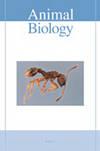3个种群西藏Batrachuperus血液学参数和红细胞大小的种内变异(尾纲:海蛾科)
IF 0.9
4区 生物学
Q2 ZOOLOGY
引用次数: 1
摘要
种内变异是自然界中常见的现象,但迄今为止,对尿虫血液学特征的这种变异的研究仍然很少。为了比较不同种群间血液学性状的种内变异,探讨吻孔长度(SVL)和体重是否影响中国西北地区三个种群(西河、梅县和太白)58个成熟西藏蝙蝠的血液学性状、血液学参数和红细胞大小。所有人群的任何血液学特征都没有性别差异。梅县和太白人群的血液学特征没有显著差异,但与其他两个群体相比,西河人群的红细胞计数(RBC)、血红蛋白(Hb)、红细胞比容(Hct)、红红细胞长度(L)和红细胞面积(A)显著较低,白细胞计数(WBC)显著较高。线性回归分析表明,SVL与Hb、RBC、Hct和L之间存在显著关系;体重与Hb、RBC、Hct和L呈负相关。在考虑SVL和体重的影响时,只有L在人群之间存在显著差异。人群之间的Hb、RBC、WBC和Hct变化可能导致SVL或体重的差异,而红细胞大小(L和A)变化可能导致Hb、红细胞和Hct较低的差异;这些变化不是栖息地变量差异的结果。我们的研究结果为理解生理种内变异提供了基础。本文章由计算机程序翻译,如有差异,请以英文原文为准。
Intraspecific variation in hematological parameters and erythrocyte size among three populations of Batrachuperus tibetanus (Caudata: Hynobiidae)
Intraspecific variation is a common phenomenon in nature, but to date, research on such variation in hematological traits of urodeles remains scarce. To compare intraspecific variation in hematological traits among populations, and explore whether snout–vent length (SVL) and body mass influence hematological traits, hematological parameters and erythrocyte size in 58 mature Batrachuperus tibetanus specimens belonging to three populations (Xihe, Meixian and Taibai) in northwestern China were analyzed. There were no sexual differences in any hematological trait for all populations. No hematological traits differed significantly between the Meixian and Taibai populations, but significantly lower values of erythrocyte count (RBC), hemoglobin (Hb), hematocrit (Hct), erythrocyte length (L), and erythrocyte area (A), as well as a significantly higher leukocyte count (WBC) were observed in the Xihe population compared with the other two. Linear regression analyses showed that significant relationships were present between SVL and Hb, RBC, Hct, and L; and body mass and Hb, RBC, Hct, and L. However, SVL and WBC were negatively correlated. Only L differed significantly among populations when accounting for the effects of SVL and body mass. Hb, RBC, WBC, and Hct variations among populations possibly contribute to differences in SVL or body mass, and erythrocyte size (L and A) variations are perhaps attributable to differences in lower Hb, RBC, and Hct; these variations are not the result of differences in habitat variables. Our results provide a foundation for understanding physiological intraspecific variation.
求助全文
通过发布文献求助,成功后即可免费获取论文全文。
去求助
来源期刊

Animal Biology
生物-动物学
CiteScore
2.10
自引率
0.00%
发文量
34
审稿时长
3 months
期刊介绍:
Animal Biology publishes high quality papers and focuses on integration of the various disciplines within the broad field of zoology. These disciplines include behaviour, developmental biology, ecology, endocrinology, evolutionary biology, genomics, morphology, neurobiology, physiology, systematics and theoretical biology. Purely descriptive papers will not be considered for publication.
Animal Biology is the official journal of the Royal Dutch Zoological Society since its foundation in 1872. The journal was initially called Archives Néerlandaises de Zoologie, which was changed in 1952 to Netherlands Journal of Zoology, the current name was established in 2003.
 求助内容:
求助内容: 应助结果提醒方式:
应助结果提醒方式:


